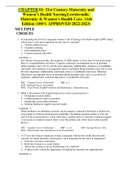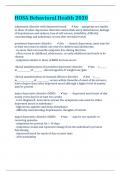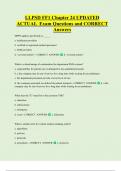Pediatrics
Foundations:
Infant: 0-12 months
Toddler: 1-3 years
Preschooler: 4-5 years
School age: 6-12 years
Adolescent: 12-20 years
Atraumatic care: to minimize physical and emotion stress and wellbeing
● Keep a routine
● Talk to child in age appropriate way
● Family centered care
Preventing physical and emotional stress:
● Engage with child, ask about comfort
● Use comfortable positioning
● Therapeutic hugging
● Use of distractions (imagery, music)
Positioning for invasive procedures:
Sitting on lap: allergy testing, IM injections
Hugging: IV insertion, injections
Cuddles over shoulder (infants): heel sticks
Impacts of hospitalization:
Infant: failure to develop bonding or trust
Toddler: difficulty with autonomy
Preschooler: difficulty to achieve initiative
School age: difficult to achieve industry
Adolescent: difficulty forming sense of identity
Pediatric pain assessments:
FACES pain scale (nonverbal, young children)
Oucher pain scale
Poker chip tool (Child gives as many chips back and indicates how much pain)
Visual analog, numeric scale
Adolescent pediatric pain tool
Factors affecting absorption:
Oral medications: gastric pH, 1st pass metabolism, hepatic diseases, slower gastric emptying
IM: variability in muscle mass
SUBQ: Decreased perfusion
Topical: body surface area
, Growth and development: Infant 0-12 months
Growth: increase in physical size
Development: neurological, musculoskeletal
Growth chart: based on infants length and weight; assesses percentile child is in
Average weight: 3,4000g (7.5lb) at birth (can lose 5-10% but gain it back within 2 weeks)
*Doubles by 4-6 months
*Triples by 1 year
Once they hit 4000g check glucose! = LGA
Average length: 50cm (20 inches at birth)
*Increases by 50% by 12 months
Average head circumference: 35cm (13.5 in at birth); measured at eyebrows around head
*Increases about 10cm by 12 months (measure until 36 months, 3 years)
Reflexes and when they disappear:
Step: 1-2 months
Root: 3 months
Suck: 2-5 months
Moro: 4 months
Tonic neck: 4 months
Plantar: 9 months
Palmar grasp: 4-6 months
Babinski: 12 months
,States of consciousness:
Deep sleep: no movement
Light sleep: eyes closed, REM
Drowsiness: eyes half closed
Quei alert: eyes open, calm
Active alert: eyes open, moving
Crying
Erikson: trust versus mistrust
-Birth to one year; infants learn that mother/ caregiver is there to provide comfort and develop
trust, caregivers respond to infants basic needs by feeding, changing, cleaning, touching,
holding
Piaget:Sensorimotor: birth to 2 years
-Develops object permanence in 4-6 months, solidified by 8 months (if you hide something the
infant still knows it exists, ex. Peek a boo)
-Infant uses senses and motor skills to learn the world
Gross motor skills: Develop in a cephalocaudal fashion (head to feet)
1 month: Lift, turns head, head lag
2 months: Raises head, chest (better control)
3 months: Raises head 45 degrees, slight head lag
4 months: lifts head, looks around, rolls prone to supine
5 months: rolls supine to prone, sits with support
6 months: Tripod position (sits with hands on floor)
7 months: Sits alone with some use of free hand
8 months: Sits unsupported
9 months: Crawling
10 months: Pulls to stand, “cruises”
12 months: Sits from standing, walks independently
Fine motor skills: Develop in a proximodistal fashion (Center to periphery)
1 month: clenching fists
3 months: hands open intentionally
4 months: batting at objects
5 months: grasping objects
6 months: releases objects
7 months: transfers from one hand to another
8 months: gross pincer grasp (raking)
9 months: bangs objects
10 months: fine pincer grasp (picks things up with thumb and forefinger)
12 months: feeds self with cup and spoon, simple marks on paper, pokes with index finger
, Senses:
Nearsighted
Hearing intact at birth
Sense of smell and taste intact (prefers sweet)
Sense of touch present (most important for soothing an infant)
Warning signs:
● Does not respond to loud noises, does not turn head to noises
● Does not focus on near objects
● Not babbling making sounds by 4 months
● Crossing of eyes >6 months
Communication:
1st few months: crying
1-3 months: “cooing”
4-5 months: simple sounds, responds to name
7-10 months: babbling
9-12 months: meaning to words
12 months; can say 2-3 words
Warning sounds:
● No sounds by 4 months
● Not laughing or squealing by 6 months
● Not babbling by 8 months, no words with meaning by 12 months
Social/ emotional:
Stranger anxiety develops around 8 months
Recognizes self is separate
Separation anxiety
Temperament
Safety:
Car safety: not unattended, must go home in carseat, backwards seating until >2 and >20lbs ,
center of the back seat
Firm cribs, slats no wider than <6cm, fitted sheets, empty crib
Advise against infant walker
Safety gates, secure cabinets
Choking (any small objects/ foods. Ex. popcorn, raw veggies, hotdogs, grapes)
Water safety
Sleep/rest:
“Back to sleep, prone to play”
Newborns: sleep up to 20h/ day
3 months: sleep 7-8h/ night, 2-3 naps/ day
Foundations:
Infant: 0-12 months
Toddler: 1-3 years
Preschooler: 4-5 years
School age: 6-12 years
Adolescent: 12-20 years
Atraumatic care: to minimize physical and emotion stress and wellbeing
● Keep a routine
● Talk to child in age appropriate way
● Family centered care
Preventing physical and emotional stress:
● Engage with child, ask about comfort
● Use comfortable positioning
● Therapeutic hugging
● Use of distractions (imagery, music)
Positioning for invasive procedures:
Sitting on lap: allergy testing, IM injections
Hugging: IV insertion, injections
Cuddles over shoulder (infants): heel sticks
Impacts of hospitalization:
Infant: failure to develop bonding or trust
Toddler: difficulty with autonomy
Preschooler: difficulty to achieve initiative
School age: difficult to achieve industry
Adolescent: difficulty forming sense of identity
Pediatric pain assessments:
FACES pain scale (nonverbal, young children)
Oucher pain scale
Poker chip tool (Child gives as many chips back and indicates how much pain)
Visual analog, numeric scale
Adolescent pediatric pain tool
Factors affecting absorption:
Oral medications: gastric pH, 1st pass metabolism, hepatic diseases, slower gastric emptying
IM: variability in muscle mass
SUBQ: Decreased perfusion
Topical: body surface area
, Growth and development: Infant 0-12 months
Growth: increase in physical size
Development: neurological, musculoskeletal
Growth chart: based on infants length and weight; assesses percentile child is in
Average weight: 3,4000g (7.5lb) at birth (can lose 5-10% but gain it back within 2 weeks)
*Doubles by 4-6 months
*Triples by 1 year
Once they hit 4000g check glucose! = LGA
Average length: 50cm (20 inches at birth)
*Increases by 50% by 12 months
Average head circumference: 35cm (13.5 in at birth); measured at eyebrows around head
*Increases about 10cm by 12 months (measure until 36 months, 3 years)
Reflexes and when they disappear:
Step: 1-2 months
Root: 3 months
Suck: 2-5 months
Moro: 4 months
Tonic neck: 4 months
Plantar: 9 months
Palmar grasp: 4-6 months
Babinski: 12 months
,States of consciousness:
Deep sleep: no movement
Light sleep: eyes closed, REM
Drowsiness: eyes half closed
Quei alert: eyes open, calm
Active alert: eyes open, moving
Crying
Erikson: trust versus mistrust
-Birth to one year; infants learn that mother/ caregiver is there to provide comfort and develop
trust, caregivers respond to infants basic needs by feeding, changing, cleaning, touching,
holding
Piaget:Sensorimotor: birth to 2 years
-Develops object permanence in 4-6 months, solidified by 8 months (if you hide something the
infant still knows it exists, ex. Peek a boo)
-Infant uses senses and motor skills to learn the world
Gross motor skills: Develop in a cephalocaudal fashion (head to feet)
1 month: Lift, turns head, head lag
2 months: Raises head, chest (better control)
3 months: Raises head 45 degrees, slight head lag
4 months: lifts head, looks around, rolls prone to supine
5 months: rolls supine to prone, sits with support
6 months: Tripod position (sits with hands on floor)
7 months: Sits alone with some use of free hand
8 months: Sits unsupported
9 months: Crawling
10 months: Pulls to stand, “cruises”
12 months: Sits from standing, walks independently
Fine motor skills: Develop in a proximodistal fashion (Center to periphery)
1 month: clenching fists
3 months: hands open intentionally
4 months: batting at objects
5 months: grasping objects
6 months: releases objects
7 months: transfers from one hand to another
8 months: gross pincer grasp (raking)
9 months: bangs objects
10 months: fine pincer grasp (picks things up with thumb and forefinger)
12 months: feeds self with cup and spoon, simple marks on paper, pokes with index finger
, Senses:
Nearsighted
Hearing intact at birth
Sense of smell and taste intact (prefers sweet)
Sense of touch present (most important for soothing an infant)
Warning signs:
● Does not respond to loud noises, does not turn head to noises
● Does not focus on near objects
● Not babbling making sounds by 4 months
● Crossing of eyes >6 months
Communication:
1st few months: crying
1-3 months: “cooing”
4-5 months: simple sounds, responds to name
7-10 months: babbling
9-12 months: meaning to words
12 months; can say 2-3 words
Warning sounds:
● No sounds by 4 months
● Not laughing or squealing by 6 months
● Not babbling by 8 months, no words with meaning by 12 months
Social/ emotional:
Stranger anxiety develops around 8 months
Recognizes self is separate
Separation anxiety
Temperament
Safety:
Car safety: not unattended, must go home in carseat, backwards seating until >2 and >20lbs ,
center of the back seat
Firm cribs, slats no wider than <6cm, fitted sheets, empty crib
Advise against infant walker
Safety gates, secure cabinets
Choking (any small objects/ foods. Ex. popcorn, raw veggies, hotdogs, grapes)
Water safety
Sleep/rest:
“Back to sleep, prone to play”
Newborns: sleep up to 20h/ day
3 months: sleep 7-8h/ night, 2-3 naps/ day







